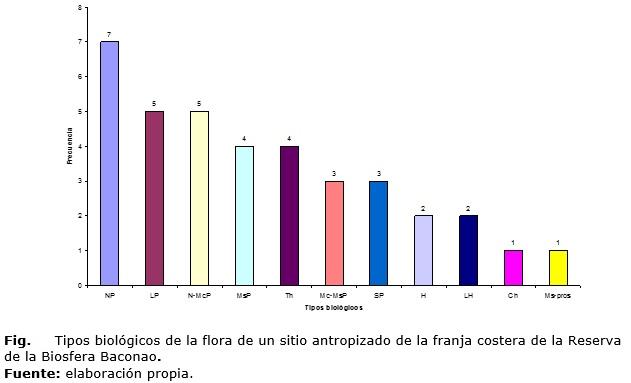Proposal of ecological rehabilitation of degraded site in the coastal band of the Biosphere Reserve Baconao
Main Article Content
Abstract
Downloads
Article Details
References
ALAIN, H. Flora de Cuba 3. Dicotiledóneas: Malpighiaceae a Myrtaceae. La Habana: Contr. Ocas. Mus. Hist. Nat. Colegio «De La Salle» 13. 1953.
ALAIN, H. Flora de Cuba. Suplemento. La Habana: Instituto Cubano del Libro. Organismos, 1974.
ALAIN, L. Flora de Cuba 5. Rubiaceae-Asteraceae. La Habana: Asoc. Est. Cien. Biol. Publ. Univ. Cuba. 1964.
BARRERA, J. I. Manual para la restauración ecológica de los ecosistemas disturbados del distrito capital. Bogotá, Colombia: Secretaría Distrital de Ambiente (SDA), Pontificia Universidad Javeriana (PUJ). 2010.
BIOECO (Centro Oriental de Ecosistemas y Biodiversidad). Plan de manejo de la Reserva de la Biosfera Baconao. BIOECO, 2013.
BORHIDI, A. Phytogeography and Vegetation Ecology of Cuba. Budapest: Akademiai Kiado, 1991.
CAPOTE, R. P. Y BERAZAÍN, R. Clasificación de las formaciones vegetales de Cuba. Rev. Jard. Bot. Nac., 1984, 5(2): 27-75.
FIGUEREDO, L. M. Y ACOSTA, F. Objetos de conservación de la flora y la vegetación de los cerros calizos costeros de la reserva de la Biosfera Baconao, Santiago de Cuba. Foresta Veracruzana, 2008, 10(2): 9-16.
FIGUEREDO, L. M. Caracterización de la vegetación de las Terrazas Costeras de la Reserva de la Biosfera Baconao, Santiago de Cuba, Cuba. BRENESIA, 2012, 78: 25-33.
FIGUEREDO, L. M. Estudio florístico de los Cerros Calizos Costeros de la Reserva de la Biosfera Baconao, Cuba. POLIBOTÁNICA, 2009, 28: 69-117.
FONSECA, G. Estructura del bosque de manglar de la Reserva de Biosfera Baconao, Cuba. Tesis de Diploma inédita, Departamento de Biología, Universidad de Oriente, 2007.
LEÓN, H. Flora de Cuba 1. Gimnospermas. Monocotiledóneas. La Habana: Contr. Ocas. Mus. Hist. Nat. Colegio «De La Salle». No. 8, 1946.
LEÓN, H. Y ALAIN, H. Flora de Cuba 2. Dicotiledóneas: Casuarináceas a Meliáceas. La Habana: Contrib. Ocas. Mus. Hist. Nat. Coll. La Salle., No. 10, 1951.
LÓPEZ, A., RODRÍGUEZ, M. Y CÁRDENAS, A. El endemismo vegetal del Turquino (Cuba Oriental). Fonqueria, 1994, .39: 395-431.
MARTÍNEZ, E. Y ALVERSON, W. S. Plantas vasculares terrestres. En: Rapid Biological Inventories. Report 10. Cuba. Siboney-Juticí: Eds: Fong, A.; D. Maceira; W. S. Alverson and J. M. Shopland. Chicago: The Field Museum, 2005, p. 52-54.
MATOS, J. Manual de Manejo de Flora Silvestre para especialistas técnicos de áreas protegidas. Villa Clara: Editorial Feijoo, 2006. ISBN: 959-250-233-1.
MATOS, J. Y BALLATE, D. ABC de la Restauración Ecológica. Villa Clara: Editorial Feijoo, 2006. ISBN: 959-250-242-0.
NÚÑEZ, A. Y VIÑA, N. 1989. Regiones Naturales Antrópicas. Nuevo Atlas Nacional de Cuba. Inst. Geografía e ICGC.
OIMT 2002. Directrices de la OIMT para la restauración, ordenación y rehabilitación de bosques tropicales secundarios y degradados. OIMT Serie de políticas forestales No. 13. OIMT, CIFOR, FAO, UICN y WWF Internacional. ISBN 4-902045-05-2.
REYES, O. J. Clasificación de la vegetación de la Sierra Maestra. Biodiversidad de Cuba Oriental, 2006, 8: 28-42.
SAMEK, V. Regiones Fitogeográficas de Cuba. Serie Forestal No. 15. ACC. La Habana. 1973.
VARGAS, O. Los pasos fundamentales en la restauración ecológica. En: La restauración ecológica en la práctica: Memorias del I Congreso Colombiano de restauración ecológica y II Simposio Nacional de experiencias en restauración ecológica. Vargas, O. y Reyes, S. Editores. Universidad Nacional de Colombia. Gente Nueva Editorial. Bogotá, Colombia, 2011, 19-40 p. ISBN 978-958-719-741-9.


